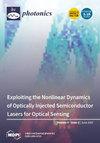Numerical Simulation of the Laser Welding Process for Diamond Saw Blades
IF 2.1
4区 物理与天体物理
Q2 OPTICS
引用次数: 0
Abstract
The development and application of laser welding transition layer technology is pivotal for manufacturing high-performance diamond saw blades. Despite its importance, there is a need for more precise modeling to optimize welding parameters and enhance blade performance. This study employs SYSWELD software to simulate the laser welding process, demonstrating high accuracy in predicting the molten pool shape. A cross-scale multi-field coupling model was established using the finite element method, incorporating temperature field, phase transformation, grain morphology, stress field, and fatigue performance. A comprehensive life cycle assessment identified optimal welding parameters. The results indicate that a laser welding speed of 26 mm/s and a power of 1700 W minimize weld stress, reduce the digital volume correlation (DVC) value, and enhance fatigue resistance. Additionally, welding tests confirmed that using 1700 W produced the highest tooth strength of 1200 MPa, validating the simulation results. This study addresses existing gaps in modeling accuracy and parameter optimization, offering a robust framework for improving the performance and reliability of laser-welded diamond saw blades.金刚石锯片激光焊接工艺的数值模拟
激光焊接过渡层技术的开发和应用对于制造高性能金刚石锯片至关重要。尽管其重要性不言而喻,但仍需要更精确的建模来优化焊接参数和提高锯片性能。本研究采用 SYSWELD 软件模拟激光焊接过程,在预测熔池形状方面具有很高的准确性。采用有限元方法建立了一个跨尺度多场耦合模型,其中包含温度场、相变、晶粒形态、应力场和疲劳性能。综合生命周期评估确定了最佳焊接参数。结果表明,26 mm/s 的激光焊接速度和 1700 W 的功率可最大限度地降低焊接应力,减少数字体积相关性(DVC)值,并增强抗疲劳性。此外,焊接测试证实,使用 1700 W 可产生 1200 兆帕的最高齿强度,从而验证了模拟结果。这项研究填补了建模精度和参数优化方面的现有空白,为提高激光焊接金刚石锯片的性能和可靠性提供了一个强大的框架。
本文章由计算机程序翻译,如有差异,请以英文原文为准。
求助全文
约1分钟内获得全文
求助全文
来源期刊

Photonics
Physics and Astronomy-Instrumentation
CiteScore
2.60
自引率
20.80%
发文量
817
审稿时长
8 weeks
期刊介绍:
Photonics (ISSN 2304-6732) aims at a fast turn around time for peer-reviewing manuscripts and producing accepted articles. The online-only and open access nature of the journal will allow for a speedy and wide circulation of your research as well as review articles. We aim at establishing Photonics as a leading venue for publishing high impact fundamental research but also applications of optics and photonics. The journal particularly welcomes both theoretical (simulation) and experimental research. Our aim is to encourage scientists to publish their experimental and theoretical results in as much detail as possible. There is no restriction on the length of the papers. The full experimental details must be provided so that the results can be reproduced. Electronic files and software regarding the full details of the calculation and experimental procedure, if unable to be published in a normal way, can be deposited as supplementary material.
 求助内容:
求助内容: 应助结果提醒方式:
应助结果提醒方式:


